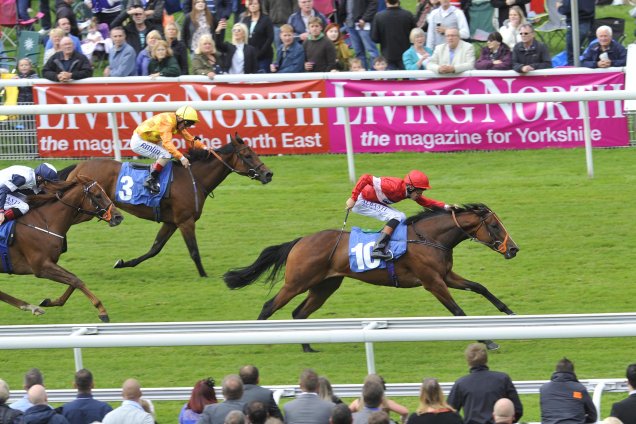3 minute read
Keith Melrose investigates how two-year-olds tend to fare in the Nunthorpe Stakes, and what the efforts of other recent runners say for ante-post favourite Acapulco.

“A runaway winner for the Weatherby’s Super Sprint. Tiggy Wiggy bolted up.”
No sooner had Tony Ennis finished his Super Sprint commentary than the calls to run Tiggy Wiggy in the 2014 Nunthorpe Stakes began. Her ever-adventurous trainer Richard Hannon seemed happy to ride the wave at first, but within a couple of days her meeting with the older sprinters was deferred until the Prix de L’Abbaye. By one minor misfortunate or another, we are still waiting.
When a trainer has the gumption to send a Queen Mary runner-up into the Super Sprint under a big weight, then shies away from the Nunthorpe even after she wins by half the track, it speaks pretty emphatically about the perceptions of trying a two-year-old against older horses.
Timeform often lead the calls for prodigious juveniles to be tried in the Nunthorpe Stakes. We don’t beat that drum to be populist, nor hipster. It’s hard-wired into our methods, specifically our weight-for-age scale, which has existed in something similar to its present form for upwards of 20 years. Under the Nunthorpe’s conditions- five furlongs in mid-to-late August- our scale would advise an allowance of 17 lb for two-year-olds. The BHA offers 24 lb to the same horses, with an extra 3 lb for fillies. We simply encourage trainers and owners to take advantage of what we see as a free allowance in a Group 1.
Wesley Ward and Coolmore are not hesitating for a second time after passing up their own shot at the Nunthorpe last year with Hootenanny. For Acapulco, who blew away the field in this year’s Queen Mary, the path from Royal Ascot to York has had no diversions: she’s going for the Nunthorpe, and that’s that. It’s what we’ve come to expect of Ward, whose firmness in his convictions matches all our images of the American frontiersman. The fact his owners happen to sponsor this latest unbroken territory is an almost unnecessary kicker.
For all we bemoan the missed opportunities like Tiggy Wiggy, the path before Acapulco has actually had a lot more wear in recent years. Only four two-year-olds ran in the Nunthorpe between Lyric Fantasy’s win in 1992 and that of Kingsgate Native in 2007. The latter’s success has inspired seven more to try in as many subsequent renewals.
In total over the last decade, we’ve had a total of nine two-year-olds run in the Nunthorpe. Though a small sample, it’s one worth analysing, especially as we have a big enough body of runners from other age groups to put them up against. Our usual first measure, percentage of rivals beaten, provides the following results:

You can’t really deny that these figures make grim reading for the two-year-olds. It does mask the significance of the data, though. The following boxplot, a far more in-depth effort crafted by Timeform Data Analyst Tom Heslop, plots the cumulative distance beaten in lengths for the same age groups. In short, the position of the box tells us how good a group has been, the width of the box tells us how varied, and the thick vertical line is the median.

The two-year-olds are still struggling, but that huge variance starts to tell the story a little more. The small size of the sample plays a big part, of course, but it’s also a symptom of its remarkably binary nature. Incidentally, note that three year-olds and older horses perform extremely similarly (a higher variance with the three-year-olds being chiefly down to the sample, which is a little more than a quarter of the size) and that our weight-for-age for three-year-olds in the Nunthorpe is, at 2 lb, identical to the BHAs.
The blessing of dealing with a sample of nine is that we can take it down to the atomic level- and here we see the pertinent point with two-year-olds in the Nunthorpe. Here are the %RBs for each individual runner, in descending order.

If the conclusion wasn’t immediately obvious from the data, the thick red line should knock it home. There is a virtually polar distribution among the sample, an inverted bell curve, which only gets worse when you take into consideration the fact that Dinkum Diamond, Shyrl and Percolator all beat other two-year-olds in their respective years- they would otherwise be on 40%, 18.18% and 9.09% respectively.
We must allow for selection bias: it’s no coincidence that the highest concentration of juveniles sent into the Nunthorpe came in the years following Kingsgate Native’s success. Plenty of those were precocious, rather than true Group 1 horses. Connections were lulled in by the snazzy advert, only to find the product not to their charges’ liking.
The ultimate conclusion doesn’t change: two-year-olds can take advantage of the generous weight allowance in the Nunthorpe, but you need the right sort of two-year-old to do it. Selection bias says that the odds are better than two-in-nine, too, once you weed out the chancers.
What sort of two-year-old do we need? Now we’re dealing with a sample of two- Kingsgate Native and Radiohead- and that is impossible to draw firm conclusions from. However, two factors, both virtually unquantifiable, link Kingsgate Native and Radiohead: maturity and size. Though buzzy, Radiohead (described as ‘lengthy, useful-looking’ by us) was able to deal with all the traffic problems thrown at him in the Norfolk and still come through to win, while the ‘strong, lengthy’ Kingsgate Native had conceded the rail to eventual Group 1 winner Fleeting Spirit in the Molecomb and yet lost by only a neck.
If build and professionalism turn out to be the two major attributes besides ability for a two-year-old to excel at York, then Acapulco has no concerns. Given the rare physical description of ‘big, powerful filly’ by our racecourse reporter at Royal Ascot, she was impressively straightforward in the Queen Mary, getting no cover and racing alone for the final two furlongs but keeping an essentially true line up Ascot’s rise to the finish.
Acapulco is ready- born ready, like most of Wesley Ward’s juveniles seem to be. She’s also the highest-rated two-year-old to run in the Nunthorpe in a long time, her 117p figure 2 lb higher than Kingsgate Native at the same stage, while she also receives that extra 3 lb fillies’ allowance.
What’s gone before suggests you need a certain kind of juvenile to cut it with the older horses; a monstrously-built, lightning-quick, clued-up, Wesley Ward-trained filly would be virtually the hand-crafted choice. At an Ebor festival that’s gaining in intrigue by the day, Acapulco’s bid for the Nunthorpe Stakes has Timeform, long-time cheerleaders for sprinting youth over experience, more excited than anything else.






